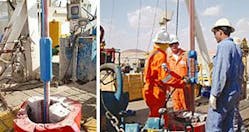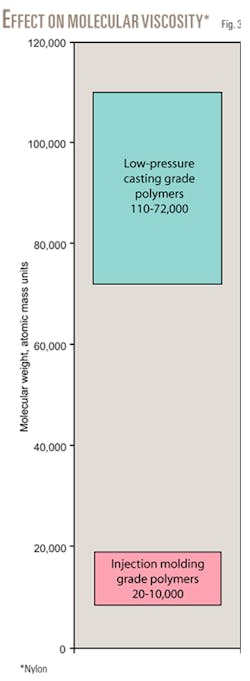Polymers can be cast at low pressures, rather than injection-molded, to produce engineering-grade components for downhole use.
Like many other industry sectors, the upstream oil and gas industry has traditionally been reluctant to embrace polymers. Perhaps this is because compared to metals, their make-up tends to be far more difficult and less well documented by the material standards that we have come to expect for steels. Quite often, this is because the polymer chemical composition is proprietary to the chemical producers.
The majority of material knowledge in the industry being based in steel could also have hampered the earlier application of polymers in wells. In recent years, however, new polymer products have been used successfully and are gaining a far wider acceptance in the downhole well environment.
Why polymers downhole?
Clearly polymers have found a traditional niche in pressure-sealing applications where their properties are often essential. More recently in the oil field marine environment, their resistance to corrosion and low specific gravity have given them an advantage in such applications as buoyancy reduction, particularly in deep water.
But engineers have been slow to use cast polymers to solve the more arduous challenges in drilling and completions or to perform downhole functions. Challenging wellbores may exhibit increased mechanical dynamics, and difficult well environments impose additional constraints on any design or materials used in wellbore construction and well completion techniques.
It is in well engineering applications that more discussion has been generated of late, polymer products being more widely proven in some of the toughest well applications around the globe.
So the question may be asked as to why there has been a shift to these “alternative materials.” Some would argue that this is a natural evolution, which we have seen in other industries (automotive), but it is more likely for three other main reasons.
First, the drive from within the drilling industry to explore and exploit deeper and farther has brought up new issues such as increased friction while running in hole.
The arrival of more advanced well instrumentation and zonal control has meant that more completion “jewelry” and the associated control lines and cables require improved protection in the horizontal and often openhole environment.
Regions with deep water or harsh environmental conditions, such as the UK’s Atlantic coast, have also imposed new constraints on the umbilical cables commonly used to control critical safety equipment on completion, landing, and workover strings run from semisubmersible drilling rigs.
Second, safety concerns are increasingly prominent criteria for choosing equipment-much of which has to be handled manually. Equipment and materials must meet the respected guideline weights for safe handling and also meet guidelines for components which are fitted repetitively. This includes lightened-weight cable protectors, which will reduce operator fatigue and improve overall safety and operational efficiencies.
Cast polymer cross-coupling protectors in the photo on the left are shown just before running into an openhole completion to protect fiber optic cables used for distributed temperature sensing in Occidental Oman Inc.'s well S179 in Oman, 2001 (Fig. 1a). Occidental fits cast polymer cross-coupling protectors in the photo below onto production tubing at the S179 well in the Omani desert (Fig. 1b).
The last and equally significant reason would be that polymer materials in suitable designs are now commercially available. These materials have the required mechanical properties and proven, qualified designs to ease the selection process for completion, subsea, and drilling engineers.
One company which has pioneered the most recent advances of polymer technologies is Aberdeen-based PolyOil Ltd. Since 2001, PolyOil has introduced a range of polymer-design cable protector clamps, umbilical protectors, and specialized centralizers to this sector of the industry (Fig. 1). Market acceptance has been demonstrated by a year-on-year doubling of use.
Cast polymer (Poly-tector) umbilical components have been used by ExxonMobil Corp., Esso, BP PLC, Expro Group International, AkerKvaerner ASA, Santos Ltd. (Indonesia), Addax Petroleum Nigeria (EOG Group), Hydrafit Ltd. (Aberdeen), ChevronTexaco Corp., FMC Corp., and Dominion Exploration and Production Inc.
Cast polymer control-line components have been used by BP, Occidental Petroleum Corp., Petroleum Development Oman, Maersk Oil Qatar AS, Canadian Natural Resources Ltd., Norsk Hydro ASA, Statoil ASA, ConocoPhillips, ExxonMobil, Apache Corp., and TotalFinaElf, with examples cited below.
Acceptance
In the early days, Polyoil experienced some reticence from operators to use new materials, although these same operators acknowledged the benefits. Fortunately the initial applications using polymer cable protector clamps were driven by a strong need to reduce friction in wells which deployed fiber-optic gauge cables across the horizontal and openhole reservoir sections (Figs. 1a, 1b).
Cast polymers have also found acceptance in the form of umbilical protectors. After first using these in the Nevis South field in April 2003 (Fig. 1c), ExxonMobil now has extensive experience running polymer umbilical protectors on completion landing strings in North Sea conditions. Polymer umbilical clamps are now commonly used in deepwater applications, including Esso’s Kizomba development in Angola (Fig. 1d).
Empirical evidence of friction reduction exists: Fig. 2 illustrates an actual completion running example in which the surface hanging weight was improved and increased by about 10,000 lb more than modeled or expected with metallic products.
Another practical example is the successful use of similarly designed centralizers. Cast polymer centralizers were used in early trials of well-known advanced drilling technologies such as casing drilling, where the polymer units not only outperformed the traditional metallic centralizers but also enhanced drilling performance.
BP took an additional step approach, initiating and completing a project last year for the Schiehallion oil field, West of Shetland, North Sea. Although satisfied with the track record of the umbilical protector design and material at the time, this end user commissioned an independent finite element analysis (FEA) to ensure that all aspects of the clamp’s design were optimized (see color image on cover). This was carried out to BP’s satisfaction and allowed further design feature enhancements to be made.
Possibly the most stringent qualification standards and testing facilities known are those devised and regularly used by Statoil and Norsk Hydro, the main operators in the Norwegian sector, where existing criteria-originally established for metallic based clamps-have been passed with the polymer equivalents.
Both operators sponsored tests of the polymer components at the RF - Rogaland Research test facility in Norway. These tests were semifull-scale based and involved evaluation of long-term wear resistance, resistance to snagging, as well as several ultimate mechanical loading tests and load cycling tests. Statoil plans to use newly designed 7-in. polymer control line protectors in its Gulltopp field (7 km west of Gullfaks, off Norway), beginning in October 2005.
Polymer manufacturing techniques
It is a misconception that all polymer formulations and methods of production are similar.
PolyOil carried over expertise from other heavy engineering industries (mining, quarrying) in which experience had shown that only certain polymers could handle abrasion and were tough enough to perform tasks (i.e., clamping or securing to tubulars) while maintaining mechanical and structural integrity. Not only is the material type important but the method of molding is also significant.
Engineering grades of polymers are not produced by the common practice of injection molding.
Injection-molded polymers, quickly and inexpensively produced, are acceptable for lighter duty components used in computer cases and automobile parts. Injection-grade materials have lower molecular weights than low-pressure cast polymers (Fig. 3, nylon example). Effectively, the molecular weight is directly related to the polymer crystallinity and hence, the density; this directly affects the mechanical properties.
The lower molecular viscosity of injection-molded polymers allows molds to be filled quickly, parts cooled, and ejected as soon as possible. This leads to a final product that does not always have the mechanical properties necessary to use in difficult applications.
The higher molecular weights and viscosities of engineering-grade cast polymers enhance their superior mechanical properties, including tensile and compressive strength, toughness (ability to withstand shock loads without fracture), and stability under high temperatures.
Advancing polymers
The umbilical and cable protectors that obviously function as clamps must be easy to assemble at a rig site. Whenever possible, they are designed to hinge and have a straightforward closing and fastening arrangement. This aspect is under continual development, relying on feedback from customers and service personnel to continuously improve product design.
PolyOil estimates that more than 20,000 polymer cable protectors have now been deployed in wells and at least 2,000 polymer umbilical protectors have been supplied and repeatedly used as many as 12 times, within the last 3 years. These applications, in tough conditions with many major operators around the world, have demonstrated that polymers can be designed and molded in complex shapes and provide the desired performance we all expect from low friction, light weight material. With success in difficult conditions, it’s likely that more applications will appear and find their way into well construction and completions.
Further technological advances in gauge and well-monitoring technology using either seismic or other proprietary surface data transmission systems have also generated a need for tubular accessories that can eliminate intertubular contact. Polymers are a natural choice because of the materials’ insulating properties. This and further new thermal insulting applications will further help secure the importance of polymers as a supporting technology used in advanced well engineering. ✦
Cast polymer cross-coupling protectors in the photo on the left are shown just before running into an openhole completion to protect fiber optic cables used for distributed temperature sensing in Occidental Oman Inc.’s well S179 in Oman, 2001 (Fig. 1a). Occidental fits cast polymer cross-coupling protectors in the photo below onto production tubing at the S179 well in the Omani desert (Fig. 1b). ExxonMobil first used umbilical protectors (top photo on the right) in April 2003 in its Nevis South field, well N10z (Fig. 1c). At the Kizomba A platform off Angola, Esso Angola ran polymer umbilical clamps (bottom photo on the right) on several drill pipe deployments after August 2004 (Fig. 1d). Photos from PolyOil Ltd.
The author
Calum Whitelaw (c.whitelaw @polyoil.com) is engineering director at PolyOil Ltd., Aberdeen. He has also served as product line manager (expandable tubular technologies, et al.) for Weatherford and as region engineer (UK sector, North Sea) for Baker Oil Tools. Whitelaw earned a BSc (Hons) in engineering from Napier University, Edinburgh, and he is a member of SPE.






